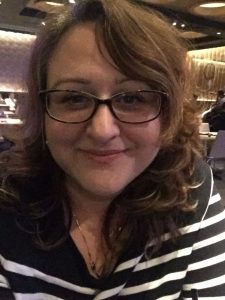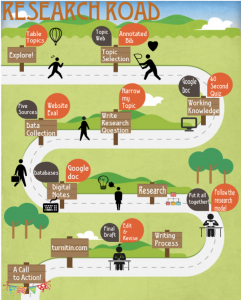


C. Gudowski at Reagan HS, San Antonio, TX
Hello, my name is Christie Gudowski, and I serve as the school librarian at Ronald Reagan High School in San Antonio, Texas. Reagan enrolls approximately 3,600 students in a suburb of the city with a predominately hispanic and white population and 12% SES, according to the state report card.
I became interested in Guided Inquiry Design as an 8th grade reading teacher. Members from my school district attended the GID training at Rutgers, including my planning partner at the time. Our incredibly compatible work relationship made the venture into GID approachable and successful. We were looking for a new research method and our students were willing to take the challenge with us. Our approach was to follow the framework and not be afraid of adjustments in our implementation as needed. We planned closely together and debriefed sometimes between class periods if we felt the need to tweak the lesson. Though we initially struggled with question-writing, like many others, the benefits of GID were apparent with on-level and advanced classes. The process made so much sense because GID was a way of organizing research in a manner that would scaffold our students’ metacognition, differentiate the process, and guide our students to success. It was what we were unknowingly looking for to deepen our student’s curiosity about the world around them and love for learning. Utilizing students’ excitement and curiosity about the 2012 Olympics, we invited Josh Davis, a local Olympian, who willingly addressed our students and shared his story during the OPEN phase of the process. This was a synergistic opportunity to share GID with our 8th graders! We were extremely pleased with the results. Our students voraciously researched, read, and shared their newly found knowledge about Olympians, Olympic sports, or Olympian history. Students’ reflections demonstrated their pride in their inquiry journals and the project overall.
After becoming a high school librarian in 2014, I strongly believed that I need to incorporate GID into research projects as I collaborated with teachers. In middle school, it is acceptable and common for teachers to spend 3-4 weeks on a single project. For factors that would take up an entire blog of their own, our high school teachers do not have that sort of flexibility in their scope and sequence. I could not abandon GID, so I found ways to introduce it to teachers in small bites throughout the school year. During my first year I asked a lot of questions like:
Reagan’s English teachers quickly realized the benefits of critical thinking required by GID process for students in their future post-secondary education. Understanding that college and career readiness is imperative for our students, the English IV on-level team worked closely with me over the last four years to take our seniors through the GID framework. Incorporation of other resources, such as Finding Your Way Through the Information Fog by William Badke, helped us create Research Road, on which we travel from November to May, as a visual for students to understand the pace and process. Research Road is an on-going work in progress, however I believe we’ve needed fewer major changes as our experience grows.

Research Road
So, that’s what I’ll be sharing with you about this week: some of my experiences on how to bridge GID from middle school to high school.
Christie Gudowski
Hi Christine,
Thank you for sharing your examples and how GID has invigorated your work with research in middle and high school. I really like how your Research Road has the writing process along the path. It’s good for teachers to recognize that all this comes before the writing, and then they will need time to revise and edit in that process time as well.
I couldn’t help but notice on your research road that you begin with Explore! What about Open and Immerse? Those are critical phases that were exposed in the ISP research (Initiation and Selection). Kuhlthau found the first three phases before Identify to be so important. I continue to find that this is a big shift for teachers to make and I dont see this Research Road clearly explicating those first three phases as we’ve laid them out in GID. We created GID using language that would be easy for teachers and students to understand so they would come to know the process, so you’re right, we want students to understand this process, too. Much like your Research Road. However, the three phases prior to topic selection are crucial. How do you support students through those three beginning phases in your work? Am I reading this wrong? Is Explore Open, then Writing knowledge is Immerse? This doesn’t exactly mirror GID so an explication would be useful here and for this audience of folks who know and understand the GID phases. Help us to understand and make clear connections between your map here and to the Guided Inquiry Design Process, if you can. Thanks!
Thank you!
Leslie Maniotes
Due to our school’s student population of over 3,600 students, it is not feasible for me to be part of every step of the framework; therefore, teachers take on the open and immerse phases in the classrooms prior to visiting the library. Our SRP focuses on student-selected social issues. The project is opened with an interest survey and personal introduction by each student in their classroom at the beginning of the year to pique interest and set the tone. Because there is such a wide range of topics, students are given journaling opportunities to reflect on social issues of personal importance, social issues addressed through other courses, and social issues presently in the media through the immersion of current event articles, video clips, podcasts, TEDTalks, and literature, etc. They are immersed in these medias for the first three months of school, as they relate to the curriculum. Our teachers put forth effort to make research authentic and I am very proud of their successes.
Christie Gudowski
Why yes! OF COURSE! The entire process cannot happen in the library! imagine the number of units the library supports in schools not even as large as yours(so many!) I often say when schools are using GID, they’ll need EVEN MORE librarians! We wouldn’t expect that all the phases occur in the library. It’s not necessary or possible. The library mainly comes into play from Explore through Gather and sometimes into Create… Is that what you find?
I’m still surprised that you don’t recognize those parts that occur in the classroom on this Research Road. I think the students would benefit from an acknowledgment of the work that came before they entered the library! Then, when they go off to do something like this on their own, they’ll recognize the amount of thought that goes into it, prior to that first explore phase.
It’s wonderful how you are collaborating and sharing the work with your classroom teachers to make the research successful and authentic!
Thank you for clarifying how those first phases work in your large school setting. This is so helpful for me and I’m sure for our readers, as well!
Looking forward to hearing more about all you are doing!
Leslie
I enjoyed reading your post! I like the questions you listed for asking high school teachers how you can help them begin to incorporate elements of GID into their curriculum. (Also, I’ve seen your marching band compete at Grand Nationals before! 🙂
Thanks for your comment, Jamie! We Rattlers love our Reagan Band!